Col d’Aspin

© Always Worth Saying2022, Going Postal
Last time on Nostalgia Album the heroic Ford 8, with a hiccup or two, commenced an odd zig-zag route across the Pyrenees as part of my father and grandparent’s 1952 return journey from Gibraltar to England. Can Puffins work out the reason for the detour? Read on! After allowing ourselves to be distracted by the Arreau – Lazermenen branch line railway, we are now traversing the Col d’Aspin. Col means ‘pass’ with the d’Aspin pass being located at number 3 on the map above.
In picture two, we are looking down the pass fairly near the summit on the eastern side. Arreau will be in the dip, on the flat, between the gap in the hills to the right in the middle distance. As the D918 wraps itself along the Pyrenean contours, similar views have been captured in the modern day via the miracle of Street View.
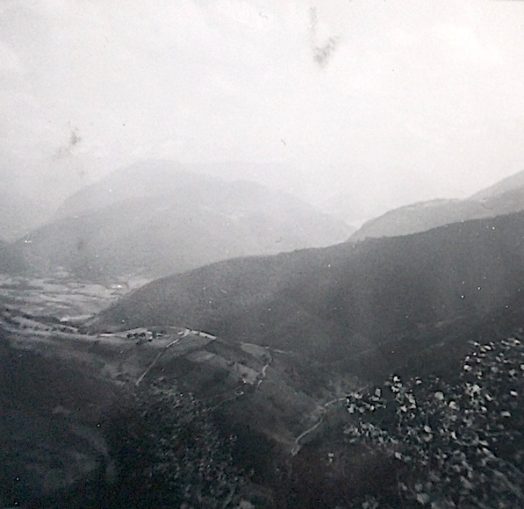
© Always Worth Saying2022, Going Postal
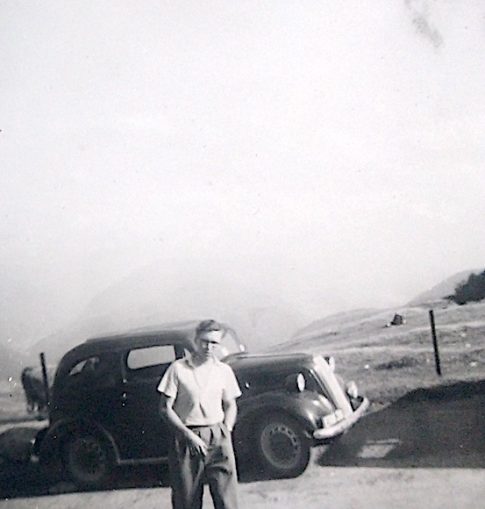
© Always Worth Saying2022, Going Postal
The hint of forestry on the right might suggest we are close to the summit. A pirouette on Street View here shows a modern-day car park which marks the top of the pass. The old sign reports the altitude as 1,490m (4,888ft) however the caption on the old photo reads 4,912ft. That caption also falsely states ‘At the top’ whereas we’re not quite at the top judging by the gradient the resting Ford 8 sits upon.
Upon reaching the summit proper, two pictures of cows reveal a hardy breed like our own Long Horns. Some are wearing bells. Despite my country origins I’m not a great expert on coos but assume the tiny udders and the fact that they’re at the top of a mountain suggests they’re not milkers.
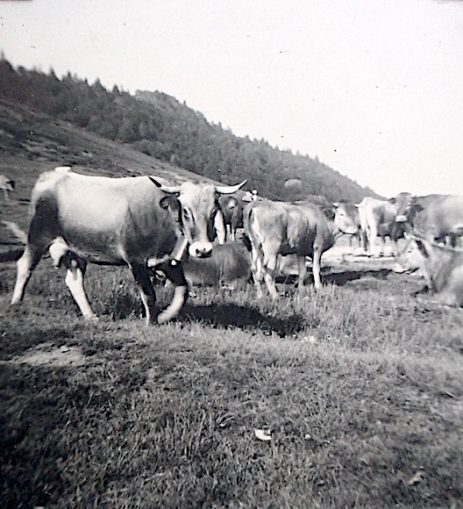
© Always Worth Saying2022, Going Postal
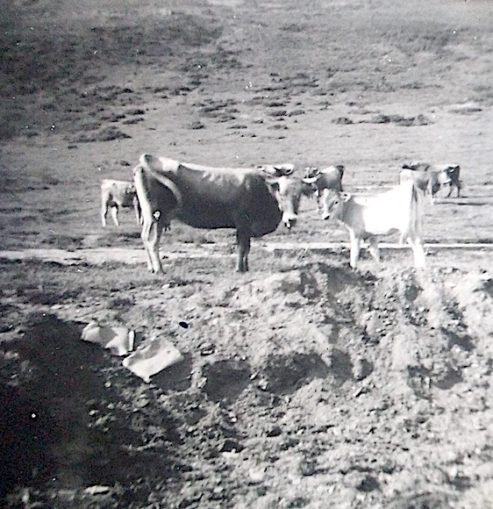
© Always Worth Saying2022, Going Postal
Further investigation, especially regarding the darkness about the flanks and the black-tipped horns, leads us to the Gascon. As every Puffin knows, back in 1952 there were two types of this breed, the à muqueuses noires and aréolé. These were combined into a single herdbook in 1955 but separated again in 1999. According to the Eat Beef, Live Better website, the Gascon is known for the hardiness of its fur, a resulting tolerance of cold weather and a thick hide that sheds water well. Native to the Pyrenees, they are used to changes in climate as they winter on the flat and summer in the hills. The Ford 8 of the animal kingdom, they can survive and work hard in basically any conditions.
A paradox running through Nostalgia Album is that things were better in the old days while simultaneously not much changes. A Street View photo from the top of the Col d’Aspin illustrates the point. The altitude sign remains, but is covered in sticky labels and is accompanied by a cycling sign telling of grades and distances. You can have a good look around via this link.

© Google Street View 2022, Google
Cows are still about the place with a walloper and his stick and dog attending to them to the right. The beasts don’t look like Garcon, more like a blonde breed. There is such a thing as a Blonde des Pyrénées but according to French wiki they’re very rare. We shall assume these to be Blonde d’Aquitaine, a breed created in the early 1960s from merging the other blonde breeds in the southwest of France to improve beef yields. Presumably, they are named after the crack express that leaves Paris Gare d’Austerlitz for the southwest every tea time. French wiki also tells us the Pyrenean and Garsonaisse were originally draught breeds, used for burden and transportation. In an earlier episode of Nostalgia Album oxen drawn carts were observed in the western, Basque, side of the Pyrenees. The ‘wheat’, as well as blonde, colouring is also characteristic of the Aquitaine.
Taking the herd to the high ground is an important time of the year and has been turned into a festival called Transhumance. Weather permitting, and on different days in different parts of the mountain range, the beasts are driven to the mountain tops sometime in late May or early June. The pasture left behind is used to grow hay for the winter. The reverse journey takes place in September with the animals confined to the farm proper when heavy snow arrives sometime between mid-November and the end of December. Depending on the valley, there may be intermediate pastures used at lower altitudes during the drive.
These days no bell can be seen around the necks. Perhaps they’ve been microchipped?
As for the Col D’Aspin itself, it has been part of the Tour de France seventy-one times including this year when it was stage 17 and a M. Thibaut Pinot was leader at the summit. The Tour goes in the other direction to our trip, west to east. Along the route, blue sign cycling information signs show distances, grades and assent for both amateur and professional cyclists alike. There are also mountain pass cycling milestones every kilometre (if you see what I mean).
Col Du Tourmalet (4)
As we continue the journey west towards number 4 on the map, the next images are of Col du Tourmalet. This is the big one and rises to 7,000 ft, more than twice the height of our own Scafell Pike. En route, we pass the site of an avalanche, with young conifer trunks cast across the ice-cold water cascading down the mountainside in a swollen gill. Further up the pass, although with cows on the high pasture we must assume it is summer, there is still ice and snow about the landscape.
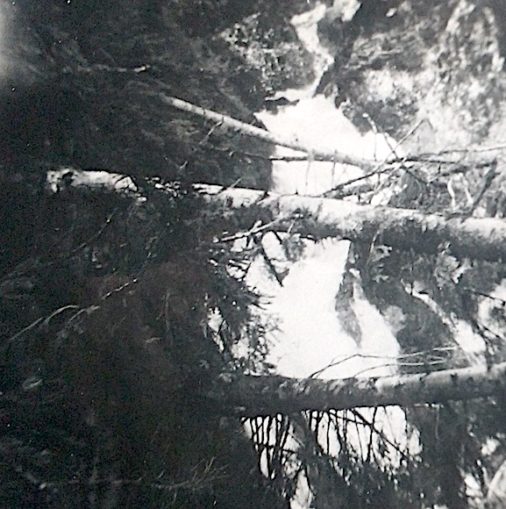
© Always Worth Saying2022, Going Postal
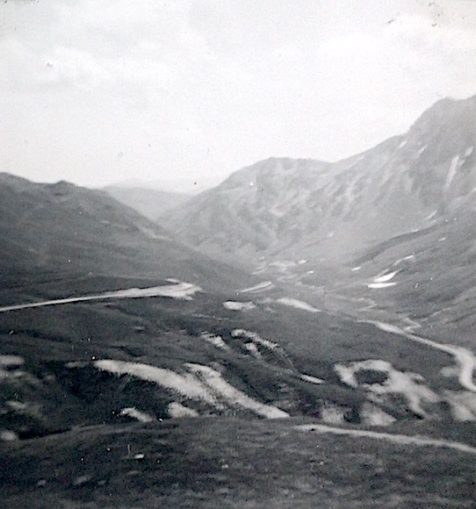
© Always Worth Saying2022, Going Postal
The actual journey to the summit has been naffed up by the French. The road has been widened, although empty of vehicles. Snow tunnels have been added. New towns of blocky apartments have been built, and what on earth is this supposed to be? Perhaps it looks better in the skiing season.
Which brings us to another recurring theme. How to develop an area economically without wrecking it. Low-paid jobs encourage a wall of immigration, much of it illegal. Ownership, control and profits pass to big corporations based elsewhere. Baffled locals are no better off while their beautiful home province is spoiled. Regular readers will recall the Spanish coast at Almeria with its 78,000 acres of plastic greenhouses. Added to this, the French have been writing on the road again, like little kids who scribble on their legs in biro, presumably because the Tour de France passes by.
Speaking of writing, as you know, the French are piccy pedants still living in the middle ages with nothing better to do than dispute the origins of words in order to ban them if they sound a bit too English. Those of us who struggled through schoolboy French while being taught by a hermit monk qualified to do so after holidaying with a cousin who’d married a Frenchman, might conclude Tourmalet means ‘tour’ for ‘journey’ and ‘mal’ for ‘bad’. Since the French say such things backwards Tourmalet translates to ‘bad journey’ which sounds about right given the twists and turns, sharp edges, ice, snow, wild-ish cattle with sharp horns, sudden drops and risk of avalanche.
However, on the other side of the Channel they insist the word is not French but Gascon (like the coos) which refers to Gascony, a region in the southwest of France which has its own dialect. As Puffins will have guessed by now from the spellings, it is a vernacular of Romance and might even be considered a variety of Occitan. In Gascon, Tourmalet means ‘long mountain’.
The French also argue over whether this is the highest pass in the Pyrenees. Apparently, it might not be. The paved roads at Cap-de-Long and Lac d’Aumer are higher but aren’t passes but rather one-way streets up to lakes. Col de Portet (that we went up last time without realising its significance) is a pass and is higher but isn’t a mountain pass as it doesn’t traverse a sufficiently pinched gap in the mountains by the time you reach the required record-breaking altitude – according to the French. We shall leave them to argue among themselves while declaring the Tourmalet the highest paved mountain pass in the Pyrenees and sharing a picture of the Ford 8 about to conquer it for England.
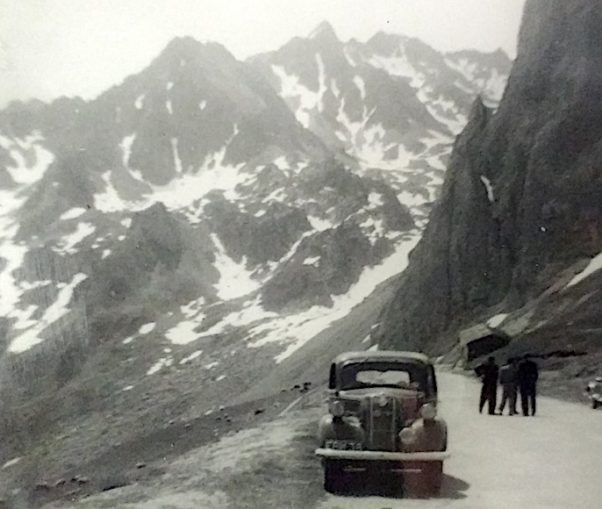
© Always Worth Saying2022, Going Postal
In the modern day we can see down the pass from a similar spot. Looking at the rockface on the right-hand side (particularly partway down the slope where a niche suddenly runs down to the road) and noting the serrations along the tops of the crags across the horizon, we can see a good match with the old photo. The hut above the people on the road has gone. Is the snow on the hillside above the Ford 8 the result of another avalanche? It does seem to have tumbled amongst the scree rather than to be the consequence of a gentle melt.
The next photo is captioned ‘At the top’ which the sign suggests is 2,114 metres (or 6,935ft). However, the caption below the album photo rounds the elevation to a nice 7,000ft. The Union Jack flies in the car’s back window. As you know, a metre is 3ft 3inchs. Or rather it isn’t, it is three foot three inches and .3701 of an inch, which makes the conversion from metric more trouble. You might say, do it as a decimal with 1 metre being 3.28051087985 feet. In the days of pen, paper and ink, rather than calculators, still too cumbersome; 7,000ft it is.
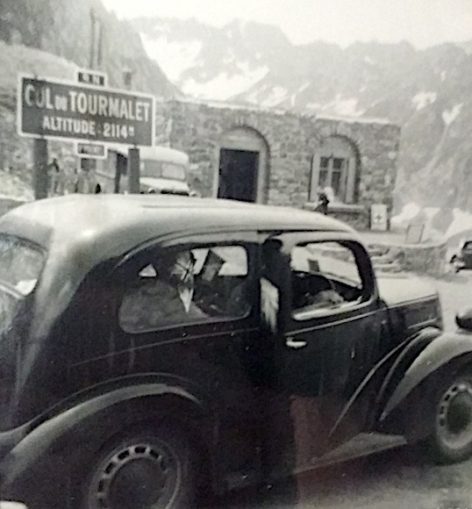
© Always Worth Saying2022, Going Postal
In modern times, the altitude sign says something else anyway. Covered in stickies as per Col d’Aspin it now reads 2,115m and sits beneath, not a statue of a Ford 8 and my relatives dressed in tweeds and cast in bronze, but a naked cyclist whistling a tune. Strewth. The rest of the summit is just as tacky with plaques and busts to French nonentities in between souvenir shops and too many vehicles and idiot foreign tourists having their photos taken.
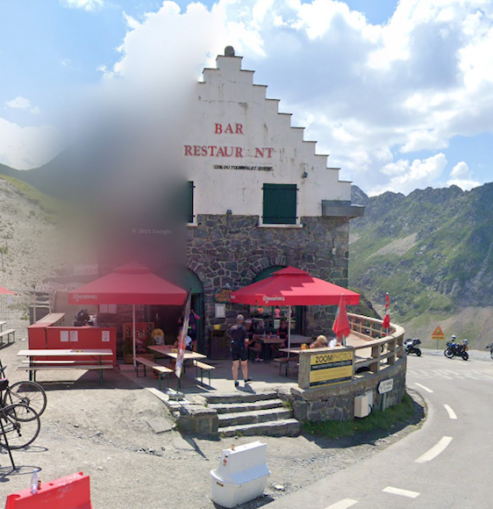
© Google Street View 2022, Google
Amazingly, the small single-story flat-roofed stone building has survived but is no longer small, flat-roofed or single-storied. Presumably originally meant for cover for those caught out by the weather, it is still there but has been extended up the way and along the way to become a bar restaurant. Heavily disguised, the giveaway is the four steps to the roadside. When comparing the old and new images, note the curvature of the wall and note also the protruding bottom step. Note also that the health and safety chaps have insisted upon a wooden fence in case those with no common sense walk off the edge and suffer a life-changing 12-inch drop.
Now that we’ve reached the summit, it is a downhill trundle all the way to Luz-Saint-Sauveur which provides a fascinating insight into Pyrenean life seven decades ago. But have Puffins worked out the reason for the detour? Do you know the destination within the destination? There have been plenty of clues. All will be revealed next time on Nostalgia Album!
Further reading
Beef to Live, Gascon cattle story
Pyrenean Way, Transhumance
© Always Worth Saying 2022


